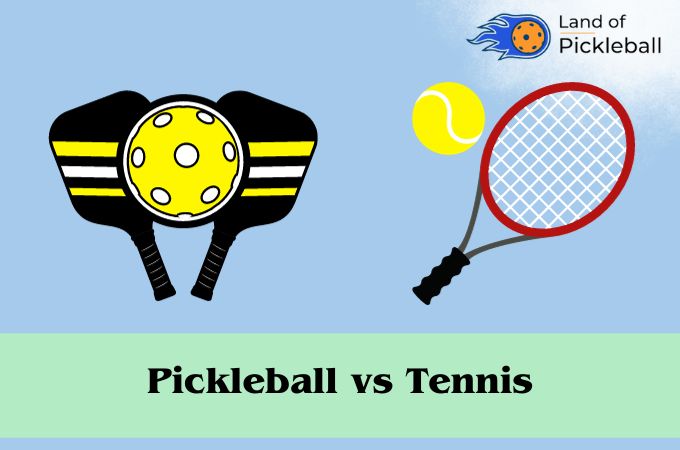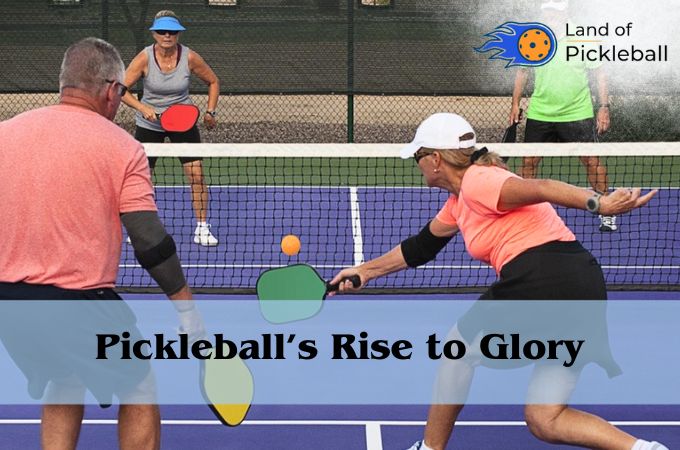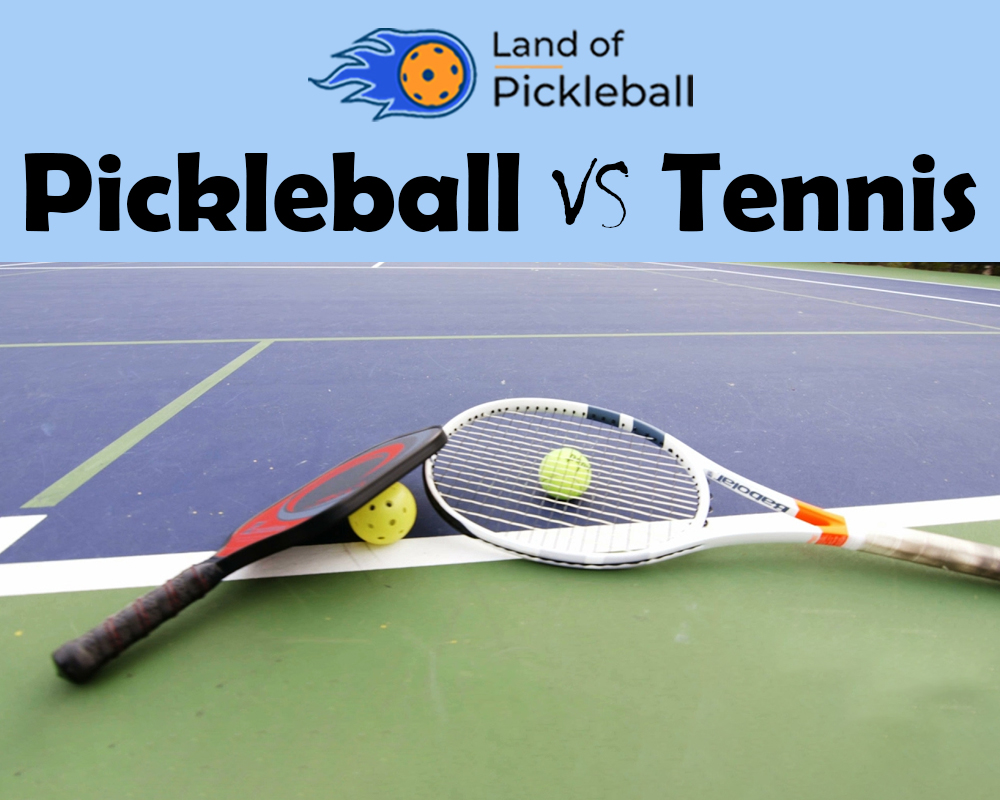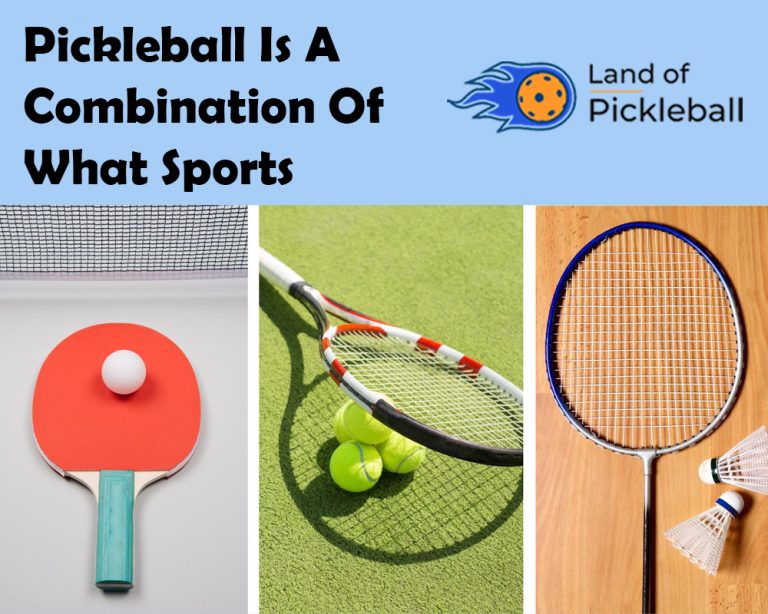Comparative Analysis of ‘Pickleball Vs Tennis’ Sports
Pickleball vs. tennis: Court, rules, and gear differ.
Tennis: big courts, rackets, heavy balls.
Pickleball: small paddles, light balls, tiny courts.
This Pickleball vs Tennis guide comprises the well-defined similarities and differences between these sports. At first glance, both sports may seem similar to beginners, but they have distinct rules, equipment, and court sizes.
Pickleball, the latest trendy racquet sport, is gaining popularity in North America. Even tennis players are joining in, swapping their tennis courts for Pickleball.
During the recent Prime tennis Tournament, the tennis court was empty due to the weather. What makes Pickleball stand out? It’s crucial to understand the differences between Pickleball and Tennis.
Moreover, Pickleball is spreading globally, and in the meantime, tennis is transforming into this new court game. Pickleball courts are on the rise.

Pickleball – The Easier Alternative to Tennis
Pickleball is the latest racquet game closely resembling tennis and offers a simpler and more accessible experience. This sport stands out with fewer rules, making it a swift transition for players of various racquet sports. What sets it apart is that formidable skills aren’t necessary; even those players who are familiar with tennis can quickly adapt to it. If you’ve played tennis, squash, table tennis, or badminton, your background becomes a valuable asset. Your stroke production skills may easily prove to master this sport Pickleball.
What Sets Pickleball Apart from Tennis?
Pickleball’s Youthful Evolution
Pickleball and tennis, both are the offspring of the racket sports family. They have distinct characteristics despite their shared ancestry. Pickleball emerged in the late 1960s, originating from a creative endeavor in a Seattle suburb. Hence, by using a badminton court and makeshift equipment like ping pong paddles and a Wiffle ball, the two families crafted a game that soon gained widespread popularity.
Tennis: A Rich Historical Sport
Tennis, with roots in ‘Real Tennis’ dating back to the 1300s, has a storied evolution. It originated from the French game ‘Jeu de Paume,’ which saw transformations with gloves and ‘battoirs’ leading to strung rackets. Major Walter Clopton Wingfield’s contributions in the mid-19th century, including early nets and rackets, paved the way for the first Lawn Tennis Championship in Wimbledon by 1877.

Core Differences
Therefore, learning the origins of these sports discloses a fascinating journey from creative family play to international prominence. It showcases the unique charm of both pickleball and tennis.
Why Pickleball Court Excites the Tennis Player?
You may know why Pickleball has become a global favorite, combining elements from tennis, table tennis, and badminton. This fast-growing sport requires minimal equipment – a small plastic ball, carbon fiber paddles, and a space smaller (1/4) than a tennis court (Source).
Unlike other sports, Pickleball is easy to pick up. This aspect makes it a preferred choice for players seeking a fun and accessible game. Learn why tennis enthusiasts are drawn to this exciting and straightforward sport.
Significant Differences of Pickleball vs Tennis Sports
Ball and Player Dynamics – Pickleball vs Tennis
| Aspect | Pickleball | Tennis |
|---|---|---|
| A longer racquet allows easy reach to lower balls | Plastic and perforated, moderate speed | Tennis ball, higher bounce, less control |
| Bounce Rules | Very few bounces allowed | Plenty of bounces allowed require precise shots |
| Player Height Impact | Taller players bend more | Advantage for shorter players, longer racquet reach |
| Racquet Reach | Limited reach due to smaller court | Longer racquet allows easy reach to lower balls |
| Court Demands | Smaller court, efficient serves | Larger court, varied demands, strategic play |
| Scoring Ease | Easy scoring, attracts diverse players | Varied gameplay, strategic scoring |
In essence, the plastic and perforated Pickleball offers controlled play at a moderate speed, setting it apart from tennis. The distinct bounce rules, player height impact, and court demands contribute to the unique dynamics of Pickleball. It makes this a sport of choice for diverse players.
Pickleball equipment stands out for its lighter and more compact design compared to tennis gear
Equipment Distinctions – Pickleball Paddles vs Tennis Racquets
| Aspect | Pickleball Paddles | Tennis Racquets |
|---|---|---|
| Material Composition | Fiberglass, carbon fiber, plastic, various materials | Features a string bed for ball interaction |
| Shapes | Elongated and primarily rectangular | Varied shapes evolving with materials and technology |
| Player Preference | Closer to what tennis experts are accustomed to | Evolving shapes and materials for optimized performance |
| Exertion Ease | Easier to use, closer to hand | Requires fine-tuning swing and grip for optimal leverage |
| Surface Comparison | Solid surface similar to a table tennis paddle | Features a sting bed for ball interaction |
| Grip Characteristics | Thickened and lengthened grip | Not much thickness in the racquet grip |
So, the Pickleball paddles to Tennis racquets comparison reveals distinctions in material, shape, player preference, exertion ease, surface, and grip characteristics, influencing gameplay in each sport.

Ball Dynamics – Pickleball vs Tennis
| Aspect | Pickleball | Tennis |
|---|---|---|
| Ball Composition | Perforated plastic | Rubber with a felt exterior covering |
| Size | Same size in both sports | Same size in both sports |
| Bounce Rate | Lower bounce rate in Pickleball | Higher bounce rate in Tennis |
| Ball Speed | Moves slower in Pickleball | Moves faster in Tennis |
| Beginner-Friendly | Easier for beginners due to slower speed | Requires more skills for ball control |
| Switching Techniques | Fewer complications switching from Tennis | Different strokes, longer and varied in Tennis |
| Ball Interaction | Hard, hollow plastic ball bounces off the surface | The hard, hollow plastic ball bounces off the surface |
When comparing Pickleball and Tennis, the key difference lies in ball dynamics. It impacts the gameplay speed, ease for beginners, and the transition between the two sports.
Court Distinctions – Pickleball vs Tennis
| Aspect | Pickleball Court | Tennis Court |
|---|---|---|
| Size | 44′ by 20′ | 78′ by 36′ |
| Sections | ‘Kitchen’ (NVZ), 2 Service Areas | Service Areas, Doubles Alleys, ‘No-Man’s-Land’ |
| Net Comparison | Shorter and 6 inches lower | Standard height |
| Scoring System | 11 points (with a two-point lead) wins the game | Six games (with a two-game lead) wins the set |
| 36 inches at the sidelines, 34 inches at center | 36 inches at the sidelines, 34 inches at the center | 3 feet at center, 3.5 feet at posts |
| Court Conversion | Tennis courts may convert to Pickleball courts | Adaptation of tennis facilities for Pickleball |
The comparison of Pickleball and tennis courts reveals significant differences in size, court sections, and net characteristics. It shapes the distinct playing experiences in each sport.
Read More: Pickleball Court Dimensions

In tennis, professional players engage in extended rallies, while beginners often opt for shorter ones due to limited expertise. Tennis novices need considerable court time to practice rallies. Fortunately, Pickleball courts being shorter, make rallies more manageable, requiring swift reactions from players.
Pickleball vs Tennis Rules
| Aspect | Pickleball | Tennis |
|---|---|---|
| Serving Style | Underhand volley serve (rule 4.A.5.) | Varied, includes underhand and overhand serves |
| Serve Difficulty | Generally considered easier for beginners | Often considered more challenging in tennis |
| Drop Serve | Falls by gravity, must bounce before serving | Falls by gravity, and must bounce before serving |
| Highest Point of Contact | Limited by natural bounce, rarely above the waist | Varied, with no restrictions on hitting height |
| Similarity to Tennis Serve | Closer to tennis in drop serve aspects | Distinct differences in form and technique |
| Two-Bounce Rule (Double Bounce) | Requires two bounces – once on each side of the net | No such rule; ball can be returned after one bounce |
Scoring Differences – Pickleball vs Tennis
| Aspect | Pickleball | Tennis |
|---|---|---|
| Winning Target | 11 points (2 out of 3 games) | 2 sets (6 games per set) |
| Tournament Variation | Targets of 15 or 21 points may apply | Right-hand serve across the centerline, swap positions after each rally |
| Serving Rights | Only the serving team can score | Both teams have equal rights to score |
| Serve Position Swap | Overhead shots are allowed anytime, avoid during underhand serving | Flexible player movement, no fixed serve positions |
| Side Out Rule | After losing the rally, serve moves to the opponent team | Serve moves to the opponent partner in doubles after a lost rally |
| Shot Restrictions | Overhead shots allowed anytime, avoid during underhand serving | Overhand hits permitted during serves |
| Ball Bounce Rule | Bouncing allowed before return, fault if the ball bounces more than once | Overhead shots are allowed anytime, avoid during underhand serving |
The scoring comparison between Pickleball and Tennis highlights differences in winning targets, tournament variations, Tennis and Pickleball Serving rules, serve position swaps, side-out rules, shot restrictions, and ball bounce rules. Overall it contributes to the unique dynamics of each game.
Serving Comparison – Pickleball vs Tennis
| Aspect | Pickleball | Tennis |
|---|---|---|
| Serve Execution | Diagonally across the centerline to half the court | Diagonal serve with the service box located at the back |
| Service Box Location | In front of the opponent team | Located 4.5 feet wide on each side for doubles |
| Game Format | Can serve on the same court for singles or doubles | Standard serve for singles, wider court for doubles |
| Serve Return | Anywhere in your opponent’s court | Anywhere in your opponent’s court |
When it comes to serving, Pickleball and Tennis have distinct methods, with variations in execution, service box location, game format, and serve return.
Pickleball vs Tennis – Ease of Play Comparison
| Aspect | Pickleball | Tennis |
|---|---|---|
| Background Advantage | Suited well for players with racquet sports background | Requires extensive practice for proficiency |
| Initial Gameplay | Easy initiation for beginners on the Pickleball court | Higher complexity for beginners in Tennis |
| Stroke Techniques | Quick learning of spinning and speed control after slight practice | More technical and challenging in Tennis |
| Player Participation | Two partners can start rallies in Pickleball, anytime they want | Not possible in Tennis |
| Skill Development | Beginners can become advanced players shortly | Requires plenty of practice and lessons in Tennis |
| Serving Techniques | Effortless serves with forehand and underhand motion | Serving techniques take months to become familiar in Tennis |
| Court Size | Smaller court size, making it more suitable for indoor matches | Larger court size, commonly played outdoors |
| Overall Simplicity | More straightforward and playful for all ages | More technical and complex, especially for beginners |
Pickleball stands out as a more accessible and enjoyable sport, particularly for beginners and players of all ages.
Learn More: Pickleball is a combination of What Sports?
Are Tennis Skills Relevant in Pickleball?
Well, Pickleball sport with its smaller court and slower ball, requires less running than tennis. It offers a distinct yet rewarding workout. Meanwhile, Tennis comes with more vigorous exercise. Many tennis skills seamlessly convert to pickleball, it’s demonstrated by former tennis pros. Hand-eye coordination, footwork, and ball control are just a few examples of transferable skills between these two sports.

To play tennis can give you a head start in pickleball. Many ex-tennis pros, like Gigi Fernandez and Sam Querrey, prove that skills like hand-eye coordination and quick footwork can transfer between both games.
Pickleball’s Rise to Glory
Pickleball, once a slow burner, is now the fastest-growing sport in America, with over 36.5 million players in 2022. This surge in popularity has even attracted high-profile figures like Tom Brady and LeBron James, who own teams in Major League Pickleball. With campaigns for inclusion in the 2028 Olympics, pickleball is not just catching up to tennis; it’s surpassing it in style and numbers.

Why go for Pickleball instead of Tennis?
Firstly, it’s a gentler sport, making it ideal for those concerned about joint impact. With less running, pickleball suits all fitness levels.
Open to every age group, pickleball fosters intergenerational play. Kids can effortlessly enjoy matches of Pickleball with their grandparents. Its adaptable court size also makes finding playing areas easier, from backyards to existing tennis courts.
What sets pickleball apart is its sociability. Often played in open formats with rotating players, it creates a friendly atmosphere both on and off the courts. Post-pickleball gatherings, parties, and picnics add to the vibrant culture of this sport.

FAQs
Final Thoughts
Pickleball is gaining popularity by offering simplicity, affordability, and easy play, making it a strong competitor to tennis. In the Pickleball vs Tennis debate, it’s straightforward rules and accessible nature set it apart. While tennis may appear complex to newcomers with intricate rules and mobility challenges, Pickleball provides a quicker path to proficiency.
The close proximity of opponent teams and the shorter Pickleball travel distance result in swift rallies and attainable victories. Conversely, tennis requires a longer ball travel, adding complexity to scoring. The growth of Pickleball is driven by its exciting and approachable characteristics, establishing it as a thriving choice among racquet games.




